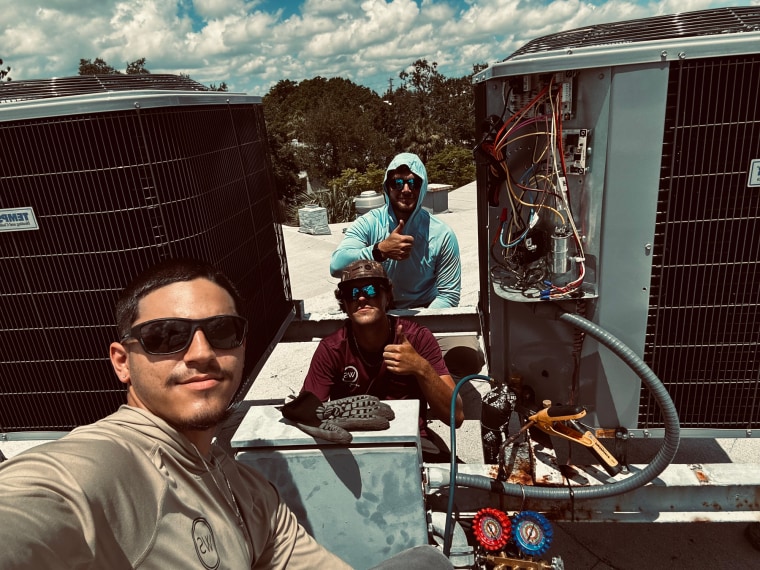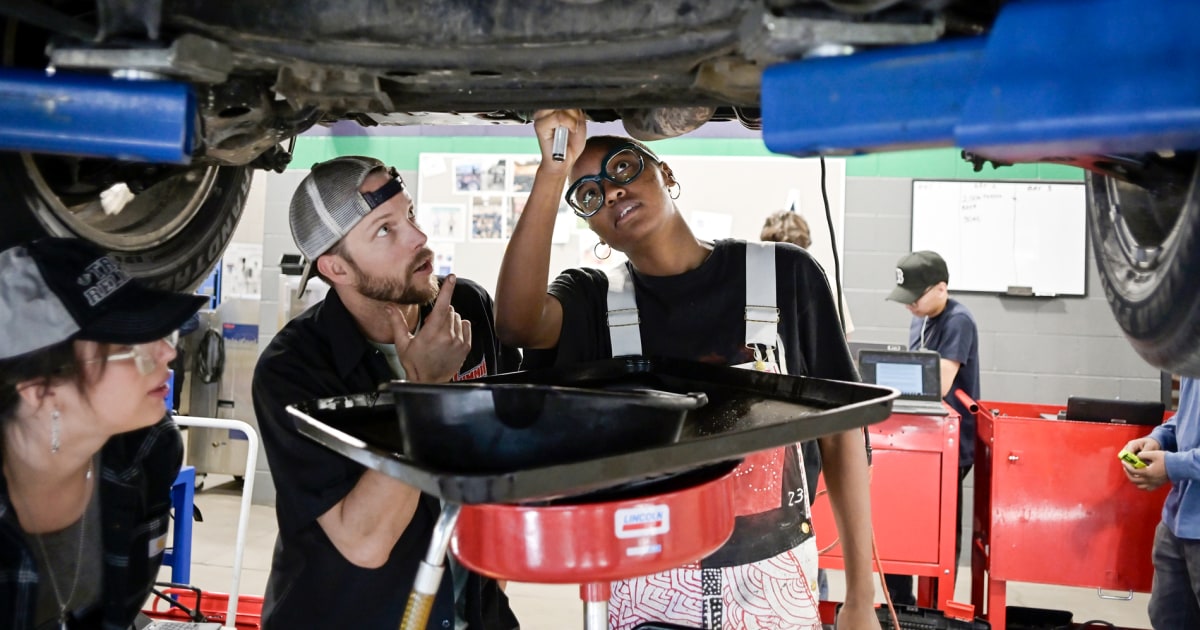Andrew Salgado knew college wasn’t for him.
Still, after graduating high school in 2023, he was set to enroll in an accounting program at a local technical college a few months later because he thought he had to.
“I was the guy who figured, ‘OK, I don’t know what I’m doing, but I can’t not go to college,’” said Salgado, 20, who lives just outside of Tampa, Florida.
But just weeks before he was set to start, Salgado’s mother convinced him to switch his major to a skilled trade by highlighting the opportunities across industries for someone with a problem-solving personality like his own.
After scouring social media for days for videos about various trade jobs, Salgado soon landed on HVAC, or heating, ventilation and air conditioning, because of his desire to help people in need. So he changed his major and eventually graduated trade school. Two years later, he’s an HVAC technician who helps fix cooling units in homes. And he can’t imagine himself doing anything else.
“I love every second of it,” said Salgado.

Salgado is one of a growing number of Gen Zers who are choosing careers in skilled trades. They’re becoming electricians, welders and HVAC technicians because of the promise of long-term stability without having to go into major student debt.
A Resume Builder survey from May, which polled 1,434 adults between the ages of 18 and 28, found that 42% of Gen Z workers say they’re turning to blue collar work with the top two motivators being avoiding student debt and not being replaced by artificial intelligence.
And last year, Gen Z accounted for nearly one in four new hires in skilled trade roles, despite making up just 14% of the total working population, according to Gusto, a payroll and benefits company.
Many are showcasing their jobs on TikTok through “day in the life” videos — posting both fun and frustrating moments — while garnering millions of views. The videos offer audiences on the app, where 1 in 3 users are between the ages of 18 and 24, a window into the trades.
Salgado’s videos often document his entire day, from brushing his teeth before the sun rises to completing several service jobs by early evening.
“I just want to show the next generation, I’m 18, 19, 20 years old in these videos, and if I could do it, you guys could too,” he said.
Adrian China, a 19-year-old electrician apprentice from New Jersey, agrees.
“It feels nice to be able to inspire people and make them do better for themselves,” said China, who often shares videos of electrical projects he finishes throughout the day.
Some say it has changed how they view the so-called American dream.
Jordan Morris, a 20-year-old HVAC tech in Richmond, Virginia, wants to work for himself. “Ten years from now, I want to start my own company,” he said.
For Salgado, it’s all about family.
“As long as I have a family, a wife, kids — that’s home for me,” said Salgado. “That’s the American dream.”
College vs. trade school
Amid skyrocketing tuition costs at four-year colleges, alongside the threat of artificial intelligence taking over white-collar roles, many young people are turning to blue-collar jobs because of the lower barrier to entry.
The average cost of a four-year college in the U.S. is about $108,000 over four years — a figure that has grown 45% in the last 20 years, when adjusted for inflation, according to U.S. News & World Report. In contrast, most trade schools range in duration from a few weeks of instruction to two years. The cost is a fraction of four-year colleges’: from a few thousand dollars to as much as $25,000 in total. Some trade schools allow students to earn a wage while they learn, while others are fully sponsored by companies where graduates plan to work.
After giving college a try twice just before the start of the Covid pandemic, Mary Millican, a 24-year-old electrician in rural Nevada, turned to a career in the trades because, she said, it allows her to have a job “whenever and wherever.”
So, she pivoted, dropped out of college and enrolled in power lineman school, and eventually electrician school. Now, as both an electrician and an assistant trade instructor, Millican said she posts videos of herself working on power lines or in the local mines to help encourage other young people, especially women, to get into the field.
“I found passion helping others on TikTok find their way in the trades,” said Millican.
High demand, low supply of trade professionals
There are millions of unfilled skilled roles, and not enough people to fill them. The BLS estimates there are 500,000 open manufacturing jobs in the U.S., and some estimates expect that number to balloon to 2 million by 2033.
Gen Z is starting to help fill that gap.
Chad Phillip, an instructor at Fred’s Appliance Academy, a trade school in Ohio, has seen the average age of his classes drop considerably in recent years. His latest class helps students become certified to fix a host of kitchen appliances in three weeks. The average age of a student is about 28 years old, with several 18-, 19- and 20-year-olds, he said.
“The biggest thing I get from the students is that they desire to be hands on,” he said. “They don’t want to sit in an office or a cubicle and do that type of work.”
The school promotes its classes on TikTok and Facebook, posting clips of students working on appliances in class. Between the platforms, the school has more than 50,000 followers, with some students admitting that they first learned of trades from the video clips.
“It is becoming more common that a student arrives on the first day of class and they’ll say, ‘Hey I saw you on TikTok or Facebook,’” said Phillip.
Over time, experts say, trades that have generally relied on word of mouth or employee referrals have begun drawing more young people via social media. And the data backs that up.
A 2024 “Future of the Skilled Trades” report by Thumbtack, a platform that connects hundreds of thousands of trade professionals to homeowners in need of home maintenance, found that 2 out of 3 Gen Zers say that social media has increased their interest in the trades. And more than half, 55%, say they would consider a career in the trades — up from the previous year, according to the poll, which surveyed 1,000 people ages 16 to 26 over two days in July last year.
Marco Zappacosta, the CEO of Thumbtack and the author of the report, said social media has a way of influencing young people more than teachers and family do.
Trade industries, he added, have long remained stable even as technology has evolved and have withstood economic downturns because of the in-demand services they provide.
Because of this, Zappacosta said, nearly 40% of the pros who have joined Thumbtack since 2024 are under 35.
“When they look at these categories, what they see is something that is likely not going away,” he said. “If your hot water heater breaks, you’re gonna hire somebody to fix it.”








